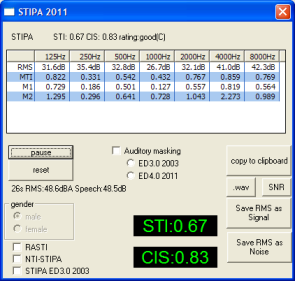Speech Transmission Index 60268-16
Speech-intelligibility is the key feature to human communication. For evacuation systems, telecommunication, announcement systems (e.g. train stations) or rooms for education, poor speech-intelligibility will degrade their function or even become a security issue.
In many countries there exist limits for the speech-intelligibility. For new public buildings a certification measurement is required and the speech-intelligibility results must be documented. In most cases this must be performed according to IEC 60849 or ISO 7240-16.
The first orginal measurements were based on statistical analysis of listening tests. In contrast, the STI-method specified in DIN/IEC 60268-16 is an objective method. It uses special test signals (modulated noise) that simulate human voice and computes the influence of a transmission channel which degrades the speech-intelligibility.
The speech intelligibility of a transmission channel depends on:
the speech level frequency response of the channel non-linear distortions background noise level quality of the sound reproduction equipment echos (reflections with delay > 100ms) the reverberation time psychoacoustic effects (masking effects)
The STI method uses 7 octave bands in the range of 125Hz to 8000Hz. It computes a single value, that reflects the speech-intelligibility. This value can be in the range of 0 to 1.0. A value of 0 is equivalent to a very poor speech-intelligibility. 1.0 is an ideal channel with excellent speech transmission.

Features
|
Conforms to IEC 60268-16:2003 and 2011 |
|
|
STI, STIPA, RASTI |
|
|
Very easy usage. Make your first STIPA measurement within 2 min. |
|
|
Measurement via modulated noise and room impulse response. (direct and indirect method) |
|
|
Background noise can be included via spectral values or .wav file. No spreadsheet calculation required. |
|
|
Auditory masking conforms to IEC 60268-16 ED 3.0 (2003) and ED 4.0 (2011) |
|
|
Displays modulation indices for each band |
|
|
Octave analyzer |
|
|
Speech level measurement according to IEC 60268-16:2011 Annex J.2 |
|
|
Easy export of data |

WinAudioMLS can perform objective speech
intelligibility measurements an addition to the room analysis module (energy decay curve and
reverberation time). WinAudioMLS calculates the speech transmission index (STI) and (room
analysis speech transmission index) RASTI according to IEC 60268-16.
The calculation is based on a measured impulse response. WinAudioMLS
calculates the modulation transfer function (MTF) with 7 octave filters (125Hz
250Hz 500Hz 1000Hz 2000HZ 4000Hz 8000Hz). The MTF is evaluated at certain modulation frequencies 0.6Hz..12Hz.
For each octave band 14 modulation frequencies are used. These values are averaged and
weighted to compute the final STI value. The STI ranges between 0 (poor) and 1 (excellent).
RASTI is a simplified version of STI. It uses only 2 bands (500Hz and 2000Hz).
WinAudioMLS displays the MTF for all bands at the specified modulation frequencies in a table.
This table can be written to a text file for storage or further analysis.
Related documentation
|
You can find the quick guide here |
|